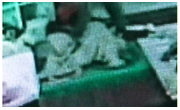본 연구에서는 일제강점기 일본 박람회에 지어졌던 조선관에 주목했다. 19세 기 후반부터 20세기까지 열렸던 해외 박람회에 전시된 조선관에 관한 연구는 그동안 서양의 박람회를 중심으로 ...
http://chineseinput.net/에서 pinyin(병음)방식으로 중국어를 변환할 수 있습니다.
변환된 중국어를 복사하여 사용하시면 됩니다.
- 中文 을 입력하시려면 zhongwen을 입력하시고 space를누르시면됩니다.
- 北京 을 입력하시려면 beijing을 입력하시고 space를 누르시면 됩니다.
일제강점기 일본 박람회에 전시된 조선관의 건축적 특징 = Architectural Characteristics of Joseon-Pavilions at Japanese Exhibitions in Japanese Colonial Era
한글로보기https://www.riss.kr/link?id=T16598210
- 저자
-
발행사항
서울 : 한국전통문화대학교 일반대학원, 2023
-
학위논문사항
학위논문(석사) -- 한국전통문화대학교 일반대학원 , 전통건축학과 , 2023. 2
-
발행연도
2023
-
작성언어
한국어
- 주제어
-
발행국(도시)
충청남도
-
형태사항
; 26 cm
-
일반주기명
지도교수: 이경아
-
UCI식별코드
I804:44031-200000668162
- 소장기관
-
0
상세조회 -
0
다운로드
부가정보
국문 초록 (Abstract)
본 연구에서는 일제강점기 일본 박람회에 지어졌던 조선관에 주목했다. 19세
기 후반부터 20세기까지 열렸던 해외 박람회에 전시된 조선관에 관한 연구는
그동안 서양의 박람회를 중심으로 이루어져 왔으며, 일제강점기 일본 박람회에
지어졌던 조선관을 건축적인 측면에서 분석한 연구는 없었다. 이에 본 연구는
일제강점기 일본 박람회에 전시된 조선관의 건축적 특징을 살펴보았다.
본 연구는 첫째, 일본 박람회에서 조선의 모습을 보여주기 위해 조선관에 차
용한 한국의 전통건축의 요소들을 분석하고, 둘째, 일시적 가설건축물의 전시관
인 조선관에 한국의 전통건축을 녹여내기 위해 어떠한 건축적 특징이 나타났는
지 고찰하는 것을 목적으로 했다.
조선관에 나타나는 실은 전시실, 매점, 접대실 및 귀빈실, 끽다실 및 식당, 휴
게실, 직원 사용 실로 구분된다. 이러한 실들은 실을 사용하는 주체와 건물에
기여하는 중요도에 따라 주용도, 부용도, 보조 용도 실로 구분할 수 있다. 각
실들은 용도에 따라 효율적인 동선을 위해 특정한 배치와 형태를 보였다.
또한 조선관의 건축구조는 주골조를 통해 건물의 뼈대를 먼저 구축한 뒤 그
겉을 나무판자로 장식해 마치 한식 목가구조인 것처럼 표현한 구조였다. 이 같
은 구조물 위에 자리 잡은 지붕가구는 서양식 트러스와 일식 목가구조였다. 이
렇듯 사용 실과 구조가 한국전통건축물과 다른 조선관은 외관을 전통건축물과
유사하게 표현하고자 한국전통건축의 특징적인 요소들을 표현하였다. 그러나 이
것 역시 세부적으로 살펴보면 전통건축의 표현과 일치하지 않았다.
위와 같은 조선관의 건축적 특징은 ‘한국전통건축물의 표현’, ‘건축 재료 및
표현의 대체’, ‘전시관으로서의 공간 확보를 위한 장치’라는 세 가지로 정리할
수 있다.
첫째, 조선관은 한국전통건축물을 모델로 축조되었다. 조선관과 관련된 각종
문헌을 살펴보면 ‘조선식 궁전조(朝鮮式宮殿造)’와 ‘조선식 문(루)(朝鮮王宮門, 朝
鮮式樓門造)’를 기본으로 형태를 구축한 것을 알 수 있다. 이를 통해 한국의 전
통건축물, 그중에서도 조선의 궁궐, 관아 건축을 모델로 삼은 것을 알 수 있다.
또한 조선관 도면과 사진 자료 등에서 한국전통건축물에서 격식이 높은 건축물
을 표현할 때 나타나는 양성바름, 장식기와, 모로단청 등의 의장 요소를 살펴볼
수 있다.
둘째, 조선관에 사용된 건축 재료 및 표현은 한국전통건축물과는 다른 방식으
로 대체되어 나타났다. 조선관 설계자는 조선관을 전통건축물의 형태로 짓고자
했지만 조선관이 한국전통건축물에 익숙하지 않은 타지에서 건설되는 점과 일
시적으로 설립되었다가 철거되는 가설건축물인 점을 고려해 빠르고 간단하게
축조해야 했다. 때문에 절충점과 타협점을 찾을 수밖에 없었는데 이는 기존의
재료를 대체하고 의장을 간략화 한 것과 건물의 정면과 후면의 의장을 다르게
표현한 것으로 나타났다.
셋째, 조선관을 전시관 용도로 사용하기 위해 공간과 지붕을 조정하였다. 전
시관으로서 조선관이 갖추어야 할 용도와 배치에 집중하고 필요한 공간을 확보
하고자 한 것이다. 이는 중층 전시관 건물의 실내 공간을 상하층으로 구분하고,
루(樓) 형태의 조선관의 하층을 실내화한 형태로 나타났으며, 절충식 지붕틀을
채택해 대규모 공간을 확보하기도 했다.
이상과 같이 본 연구에서는 일제강점기 일본 박람회에 전시되었던 조선관의
건축적 특징을 살펴보았다 그동안 . 조선관은 일제에 의해 지어진 전통식 건축물
이라고 막연히 알려져 왔다. 그러나 앞서의 고찰을 통해 당시 일본 박람회의 조
선관은 한국전통건축물의 외관과 일부 요소만을 재현하려고 했을 뿐, 건축 목적
과 건축 환경, 사용 용도 등에 따라 공간을 변형시키거나 새로운 구조와 재료를
채택하는 등 전시용 가설건축물의 특징을 가지고 있었음을 알 수 있다.
다국어 초록 (Multilingual Abstract)
The Joseon-Pavilions, displayed at the Japanese exhibition in Japanese colonial era, were built to introduce the colonial Joseon. Theses Joseon-Pavilions were construct in the form of a traditional Korean buildings. It was to introduce Joseon's archit...
The Joseon-Pavilions, displayed at the Japanese exhibition in
Japanese colonial era, were built to introduce the colonial Joseon.
Theses Joseon-Pavilions were construct in the form of a traditional
Korean buildings. It was to introduce Joseon's architecture to viewers
through the exterior of the building. However, they followed a
different pattern than traditional buildings, ranging from detailed
decoration to materials, construction methods, and use. Therefore,
this study examined the architectural characteristics of the
Joseon-Pavilions shown at the Japanese exhibition in Japanese
colonial era.
The rooms in the Joseon-Pavilions were divided into exhibition
rooms, canteen stores, reception rooms, VIP rooms, tearoom and
restaurants, lounges, and employee use rooms. These rooms could be
classified into main, secondary, auxiliary rooms according to the
target using the room and the importance of contributing to the
building. Each room displayed a specific arrangement and was
designed for efficient movement. In addition, the pavilions'
architectural structures differed from a Korean wooden house's
structure. They resembled this structure by attaching a wooden
board to the main frames of the buildings. The Joseon-Pavilions
constructed in this way were unsafe buildings. The roof furniture on
top of such a structure was a Western-style truss and a Japanese
wooden construction. Thus, the Joseon-Pavilions, which took rooms
with different use and structures from traditional Korean buildings,
depicted the characteristic elements of traditional Korean
architecture. However, the details did not match the expression of
traditional architecture.
The architectural characteristics of the Joseon-Pavilions, as
described above, can be summarized into three categories:
"Depiction of traditional Korean buildings", "Substitution of building
materials and presentation," and "Means for securing space as an
exhibition hall".
First, the Joseon-Pavilions were built as a replica of traditional
Korean architecture. Considering miscellaneous documents related to
the Joseon-Pavilions, it is apparent that the form was established
based on "Joseon-style palace building" and "Joseon-style gate
building." Thus, the modeling of traditional Korean architecture, especially the palace
of Joseon, and the architecture of government offices were evident.
In addition, in drawings and photographic materials of the Joseon
Pavilions, design elements such as Yangseongbarum, antefix, and
Morodancheong were examined when expressing formal buildings in
traditional Korean architecture. However, there was a movement to
supplement the disparity in the use of the building and the
architectural environment to imitate traditional Korean buildings
completely.
Second, the Joseon-Pavilions replaced the original architectural
materials and presented traditional buildings differently. While they
were meant to resemble traditional buildings, they had to be built
quickly and in a place unfamiliar with traditional Korean buildings.
Furthermore, they were only temporarily constructed and later demolished. Therefore, there was
no choice but to find a compromise and replace the existing
materials, simplify the design, and display the front and rear of the
building differently.
Third, the Joseon-Pavilions had a modified space and a roof
constructed to use the building as an exhibition hall. Thus, the
Joseon-Pavilion's designers tried to focus on the arrangement
necessary for the use as an exhibition hall and to ensure sufficient
space. The interior space of the middle-story exhibition hall building
was divided into upper and lower floors, and the lower floors of the
Ru-shaped pavilions became an indoor space. A compromise roof
frame was adopted to secure a large-scale space.
As described above, this study examined the architectural
characteristics of the Joseon-Pavilions displayed at the Japanese
colonial era Japanese exhibitions. Until now, these pavilions have
only been vaguely known as traditional buildings constructed by the
Japanese. However, it was found in a previous review that the
Joseon-Pavilions of the Japanese exhibitions at that time only tried
to imitate the appearance and some elements of traditional Korean
buildings. In addition, these pavilions had the characteristics of
temporary buildings for exhibitions, such as altering spaces or
adopting new structures and materials.
목차 (Table of Contents)
- Ⅰ. 서 론 1
- 1.1 연구의 배경 및 목적 1
- 1.2 선행연구 검토 2
- 1.2.1 세계 박람회 속 조선관에 관한 연구 2
- 1.2.2 일본 박람회 속 조선관에 관한 연구 4
- Ⅰ. 서 론 1
- 1.1 연구의 배경 및 목적 1
- 1.2 선행연구 검토 2
- 1.2.1 세계 박람회 속 조선관에 관한 연구 2
- 1.2.2 일본 박람회 속 조선관에 관한 연구 4
- 1.3 연구의 대상 및 방법 6
- 1.3.1 연구 대상 6
- 1.3.2 연구 방법 13
- Ⅱ. 일제강점기 일본 박람회 속 조선관 15
- 2.1 일본 박람회의 전개와 제국 일본의 식민지 전시 15
- 2.1.1 일본 박람회의 시작과 전개 15
- 2.1.2 일본 박람회의 식민지 전시 21
- 2.2 일제강점기 일본 박람회에 전시된 조선관 26
- 2.2.1 일본 박람회에 나타난 조선관의 모습 26
- 2.2.2 조선관에 대한 조선인의 인식 32
- Ⅲ. 일본 박람회 조선관의 건축적 분석 38
- 3.1 조선관의 평면계획 38
- 3.1.1 조선관에 나타나는 실(室) 38
- 3.1.2 조선관 각 실의 배치와 동선 계획 42
- 3.2 조선관의 건축구조와 비례 58
- 3.2.1 조선관의 건축구조 58
- 3.2.2 조선관의 비례 66
- 3.3 전통건축 표현을 위한 의장 77
- 3.3.1 기단부 77
- 3.3.2 축부 79
- 3.3.3 공포부 82
- 3.3.4 지붕부 85
- Ⅳ. 일본 박람회 조선관의 건축적 특징 94
- 4.1 한국전통건축물의 표현 94
- 4.1.1 ‘조선식 궁전조’의 전각 형태 조선관 96
- 4.1.2 ‘조선식 문(루)’ 형태의 조선관 104
- 4.2 건축 재료 및 표현의 대체 109
- 4.2.1 재료의 대체 및 의장의 간략화 110
- 4.2.2 건물의 정면과 후면의 의장 대비 120
- 4.3 전시관으로서의 공간 확보를 위한 장치 124
- 4.3.1 중층 건물의 실내 상하층 공간 구분 및 루하(樓下) 부분의 실내화 124
- 4.3.2 절충식 지붕틀 채택을 통한 대규모 공간 확보 130
- Ⅴ. 결론 134
- 참고문헌 138
- Abstract 143












